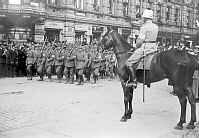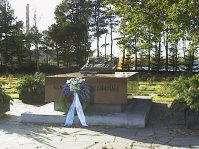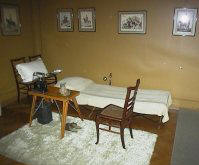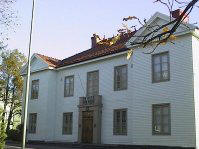C. G. E. Mannerheim, the Marshal of Finland
Written for Virtual Finland by Niklas Labart,
Researcher,
The Mannerheim Museum
Gustaf Mannerheim was born at Louhisaari Manor
in Askainen 4 June 1867 as the third child of
Count Carl Robert Mannerheim and his wife,
Helena von Julin. At the age of fourteen he was
sent to the Military Cadet School in Hamina.
Gustaf was expelled from his school for
disciplinary reasons. After passing the
matriculation examination in 1887 he decided to
enter the military profession in the Russian
army and enroled at the Nikolaevsky Cavalry
School in St. Petersburg. He first served in the
Alexandrijski Dragoons, a regiment quartered in
Poland, but was transferred after a couple of
years to the Chevalier Guards of the Empress in
St. Petersburg.
Mannerheim took part in the Russo-Japanese
war of 1904-05 as a staff officer in the
Nezhinski Dargoon Regiment and was promoted to
colonel in the battlefield. The following year
the General Staff offered him a special
commission which meant travelling on horseback
over 14.000 km (8.700 miles) from Russian
Turkestan to Beijing, China. The journey took
two years. In addition to his military mission,
Mannerheim obtained scientific material and
information for the Finnish National Museum as
well as for the Finno-Ugrian Society.

In 1911 Mannerheim was promoted to the rank of
Major General and given command of the Emperor's
Uhlans of the Guard stationed in Warsaw. He
enjoyed this position, although he was a Russian
general, the Polish aristocracy was hospitable
to him. During the First World War Mannerheim
first led operations against the Austrians as
commander of a brigade and later the 12. Cavalry
division. In 1914 Mannerheim was awarded the
Cross of St George, the highest military award
in Russia. He became Lieutenant-General and
during the last phase of the war was given
command of the 6. Cavalry Corps on the southern
front.
The Russian revolution ended his career in
the Emperor's army and in December 1917 he
returned to Finland. Mannerheim returned to a
country which had recently declared its
independence, but was torn by revolutionary
disturbances and with 40 000 Russian troops
still in the country. The Finnish Senate gave
Mannerheim the task of forming an army and
restoring law and order in the country. At the
same time as Mannerheim's troops were disarming
the Russian garrisons in the north the
revolutionary Red Guards seized power in the
south. The three-month long Civil War ended with
the victory of Mannerheim's White Army in May
1918.
 After
and partly during the war, relations between
Mannerheim and the Senate gradually became tense
as the Commander-in-Chief did not approve of the
Senate's pro-German policy. Mannerheim could
foresee the trouble Finland, whose independence
was not yet generally acknowledged, would face
by being too friendly with Germany, which was
losing the war. Owing to the Senate's mistrust,
Mannerheim resigned and went abroad where,
despite his unofficial position, he was able to
influence the politics of the winning countries
especially France and England, towards Finland.
When Germany finally collapsed, the situation in
Finland changed and Mannerheim was called back
in December 1918 to act as Regent. In Finland's
first presidential election the following
summer, he lost, however to K.J. Ståhlberg.
Mannerheim signed the constitution of the
Republic of Finland in July 1919. After
and partly during the war, relations between
Mannerheim and the Senate gradually became tense
as the Commander-in-Chief did not approve of the
Senate's pro-German policy. Mannerheim could
foresee the trouble Finland, whose independence
was not yet generally acknowledged, would face
by being too friendly with Germany, which was
losing the war. Owing to the Senate's mistrust,
Mannerheim resigned and went abroad where,
despite his unofficial position, he was able to
influence the politics of the winning countries
especially France and England, towards Finland.
When Germany finally collapsed, the situation in
Finland changed and Mannerheim was called back
in December 1918 to act as Regent. In Finland's
first presidential election the following
summer, he lost, however to K.J. Ståhlberg.
Mannerheim signed the constitution of the
Republic of Finland in July 1919.
Mannerheim tried to make Finland participate
in the Russian counter-revolutionary military
intervention operations, but retired to private
life after the attempts failed. During the
following years Mannerheim worked for the Red
Cross in Finland and for the Mannerheim League
for Child Welfare, which he had founded in 1920.
In 1931 he was appointed Chairman for the
Defence Council. In 1933 Mannerheim was awarded
the title of Field Marshal, and in 1942 he was
named Marshal of Finland.
 War
broke out in November 1939 as the USSR
started bombing Finnish cities. Mannerheim
was appointed Commander-in-Chief of the
Armed Forces, a position which he held
during the Winter War (1939-40) and the
Continuation War (1941-44).
Mannerheim did not lead only military
operations. His activities were also political.
His purpose was to prevent Finland from getting
too involved in German politics and military
aims which would have been against Finland's
interests. At the same time, collaboration
between the army and various parties at the home
front during the extended war was greatly
dependent on Mannerheim's personal prestige, and
in the end it was left for him to detach Finland
from the war.
Towards the end of the war the Parliament
appointed Mannerheim President of the Republic.
He was able to lead Finland out of the war as
the sole country on the losing side that was not
occupied by foreign troops. In 1946 Mannerheim
resigned his presidency owing to ill health. His
last years he spent quietly, mainly in
Switzerland, where he died in 1951 at the age of
83.
In 1892 Mannerheim married
Anastasia Arapova, daughter of Major General
Nicholas Arapov. They had two daughters,
Anastasia and Sofia (Sophy). The marriage was
dissolved in 1903, but officially the divorce
was not acknowledged until 1919.
|

"The one lesson above all that I wish to
stamp on the consciousness of the next
generation is this: fractiousness in
one's own ranks is more deadly than the
enemy's sword, and internal discord
opens the door to the outside aggressor.
The people of Finland have shown in two
wars that a united nation, small though
it may be, can develop unprecedented
fighting power and thus withstand the
most formidable ordeals that destiny
brings.
By closing ranks at the moment of
peril the people of Finland earned for
themselves the right to continue to live
their own independent lives within the
family of free peoples. They did not
waver in their efforts: they were made
of sound and sturdy stuff. If we remain
faithful to ourselves and if, at all
moments of destiny, we cling unanimously
and unfalteringly to the values which to
this day have been the foundation of
Finland's freedom - the faith inherited
from our fathers, the love of our
homeland and the determination and
intrepid readiness to defend it - then
the people of Finland can look to the
future with the firmest of confidence."
The final passage from the memoirs of
Marshal C.G.E. Mannerheim, published in
1950. |
 The
monument in the military burial ground of
Hietaniemi cemetery was sculpted by Väinö
Aaltonen and unveiled in 1953. The
monument in the military burial ground of
Hietaniemi cemetery was sculpted by Väinö
Aaltonen and unveiled in 1953.
 Mannerheim's
home in the Kaivopuisto district of Helsinki
(address: Kalliolinnantie 14) has, since 1951,
been a museum. The original building dated from
1874 and was the first rental house in
Kaivopuisto. Mannerheim's
home in the Kaivopuisto district of Helsinki
(address: Kalliolinnantie 14) has, since 1951,
been a museum. The original building dated from
1874 and was the first rental house in
Kaivopuisto.
At the beginning of the century the house was
owned by a prominent businessman, Karl Fazer,
and it served as living quarters at his
confectionery factory until 1924, when it was
offered for rent to Mannerheim. He had
considerable alterations made to the building,
where he lived as a tenant for the rest of his
life although there was a general belief that
the house had been a gift to him from
parliament. Parliament had inteded to donate to
him another house in Kaivopuisto, (the present
Labour Court building), to mark his 75th
birthday but the Marshal was tipped off about
the plan and made it known that he would rather
live in his existing home. Thereafter,
parliament began negotiations with the Fazer
family but the matter could not be resolved
entirely during the war years. The newspapers
did, in fact, publish a congratulatory address
from parliament, whereupon the house was handed
over to Mannerheim and he stopped paying rent.
The true facts of the matter were not revealed
until 1945 when parliament donated to Mannerheim
the money set aside for purchasing the house.
With this money, and other sums from the General
Mannerheim Fund, Mannerheim, during the same
year, acquired the Kirkniemi manor house in
Lohja.
|
For more
information please contact

MANNERHEIM
museo - museet - museum
www.mannerheim-museo.fi
Kalliolinnantie 14
00140 HELSINKI
FINLAND
Tel: + 358 - 9 -
635 443
Fax: + 358 - 9 - 636 736
info@mannerheim-museo.fi
|
Submitted by
PDG Kari Tallberg 10/11/2005
Published July 2002 |

